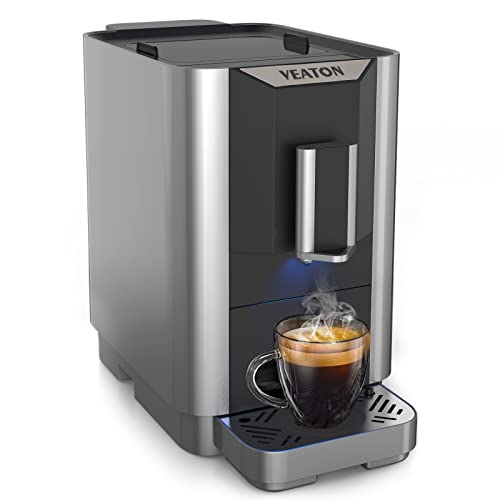How to Maintain Espresso Machines
Espresso drinks are an excellent addition to establishments like hair salons, doctors offices, and automobile dealerships. Serving these beverages will improve the customer's patience when waiting for service and enhance the atmosphere of your establishment.
This cutting-edge machine, which was a Good Housekeeping 2022 Espresso winner utilizes smart dosing to determine and disperse the exact amount of coffee ground for each shot. It also comes with a milk frothing wand that excelled in our tests for making steaming milk.
The Basics

Espresso machines can be an excellent addition to any home or office. They can be used to make many different drinks including lattes and cappuccinos. They work by forcing hot coffee through the ground under high pressure. This creates a concentrated shot of coffee that is extremely flavorful. It also has a high amount of caffeine that can be a powerful stimulant.
These machines are available in a broad range of sizes, from compact models for home use to larger ones for commercial purposes. These machines are available in semi-automatic and manual versions. Manual machines require the operator to regulate the flow of water and pressure, while semi-automatic models have an integrated pump that can do this for you. Certain semi-automatic models come with grinders, whereas others do not. The type of machine you pick will be based on your personal preferences and budget.
A manual espresso machine functions by allowing the user to move a handle to push water through the grounds that are placed in a basket for filtering. This type of machine is often called caffettiera or macchinetta, and it is the most well-known type of espresso maker. It features an inner chamber that holds the water and top chamber with an iron filter. When heated, steam is forced through the coffee grounds before being pushed into the top of the machine. This is where the espresso is ready for consumption.
Varieties
Based on your requirements, you can choose among a variety of espresso machines. There are semi-automatic, manual and fully automated espresso machines. Each machine has its own distinctive way of producing espresso shots, as well as other beverages such as lattes and cappuccinos.
The first machines weren't completely automated. They required the user to use the lever to create the pressure necessary to pull the shot. They are still in use but are less frequent due to the amount of effort required and the fatigue they could cause. Modern espresso machines produce pressure using a variety mechanisms which include screw, push and see-saw designs. This allows the user to manage pre-infusion and water volume more precisely than the lever machine.
Pump-driven espresso machines are similar to stovetop mokapots however, they use an electric pump to press the grounds of coffee instead of steam. The boiler heats water to boiling point, and the pump then pushes the water through a group head. These are the most common kinds of espresso machines and they're usually less expensive than other varieties.
Semi-automatic espresso machines bring together the best features of pump-driven and manual espresso machines. They let you grind the beans and tamp them, but the motor is responsible for controlling the pressure to ensure consistency. They also come with a separate compartment that is heated and froths milk and some come with an integrated grinder.
Functions
Commercial espresso machines make numerous espressos and coffees with the touch of a button. They make use of pre-packaged pods that are precisely dosed and packaged to make one cup of coffee or espresso. These machines are popular in busy offices because they eliminate the requirement for a grinding machine, dosing, and tamping. But, because they do not have steam functions, you'll require an additional milk frother in order to make lattes and cappuccinos.
Many cafes in Europe used steam machines to boost production and decrease brewing time. However, the early machines were heated with an open flame, which resulted in inconsistent temperature and pressure. Angelo Moriondo, an Italian inventor from Turin, is credited with creating the first machine that could brew coffee without steam.
The most common type today is the pump-driven espresso machine. These machines come with a portafilter into which ground espresso beans are packed. When the valve is turned to the espresso position and the espresso is extracted by water that is under 15 atmospheres of pressure from the heating vessel. When the brew cycle is complete, the porta-filter is removed and the drip tray is empty for cleaning.
Automated espresso machines add automation to semi-automatic systems through controlling the extraction time according to internal or volumetric timers. espresso machines uk eliminate the barista’s ability to grind or tamp coffee, which can impact the quality of the final product.
Maintenance
Espresso machines may not be the most glamorous equipment in a cafe, but they're extremely important. How an espresso machine is maintained can influence the taste of your beverages therefore it is essential to keep a regular routine that includes a daily cleaning, descaling, and a regular water filter change.
A clean espresso machine ensures that the taste of your coffee will not be ruined and your customers' experience will be great. Maintaining a regular schedule of cleanings can extend the lifespan of your espresso machine.
Use a damp cloth to clean the baskets and portafilters each time to eliminate any oil or residue. Backflush the gasket between the head of the portafilter and the grouphead by inserting the nylon brush and moving it to remove any buildup. Rinse the gasket in water and then run it through again until it is clear.
Every week or as required, mix espresso machine cleaner in a container of water following the manufacturer's instructions. Then soak the portafilters grates, and baskets for a night in the cleaning solution. If your espresso machine is equipped with a steam wand and screen, take them out of the group using an screwdriver. Make sure to separate them from the cleaning liquid.
